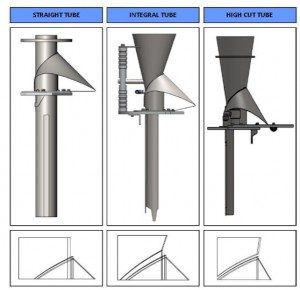The Hidden Costs of Average Forming Sets
An important consideration for food manufacturers is the cost of their packaging machinery and forming sets. To cut costs, many packagers will purchase an average forming set, which meets the minimum requirements for safety and hygiene and produces bags suitable for sale. However, the average forming set that was meant to save money up front will often result in additional, hidden costs over time.
There are some common ways in which average forming sets negatively impact the profits of food producers:
Small Stops and Reduced Output Speed
Small stops are almost always caused by product blockages, which are caused by a wide range of circumstances. Product with low mass, high surface roughness or wide-ranging variation in unit size commonly can block the former, and integral chutes are required to reduce the possibility of blockages.

The design of a straight tube in an average forming set vs a bespoke set’s tube with gradual transition.
However, average forming sets use inlet chutes that do not feature a gradual transition from the chute into the tube, which results in food getting stuck in the machine. When small stops occur, the machine must be turned off and the issue must be corrected by an engineer. Every minute that the machine is off reduces the overall output of your company.
Misaligned Tubes
Average forming sets that are fabricated poorly will feature belt flats on the tube that are not an equal distance away from the centreline of the belts. One belt will apply less pressure, which results in uneven tension and it will wear out faster than usual. As such, the belts will have to be replaced more often than they would be with a custom forming set – another hidden cost which will add up over time.
An example of tube misalignment.
Problems With Back Seals
Misaligned tubes and shoulders can compromise the quality of the back-seal on the bag, which leads to waste of material. The film may wander off to one side, which will cause the material to ripple while it is being passed through the machine. This can cause the back-seal to expose graphics that are meant to be hidden or hide graphics that are meant to be shown. In some cases, the back seal will come apart. Both food products and packaging material are wasted, which presents a significant dent in the bottom line of food producers.
At KENRAY, we have seen many customers buy average forming sets to save hundreds of pounds in the short term. Unfortunately, over time the equipment presents shortcomings that cost thousands to correct. Our bespoke forming sets prevent these issues from occurring, helping you to increase your production and output.
For more information, view our Forming Set Solutions page or give us a call at +44 (0)1530 400 100. You can also read our full white paper on the Hidden Costs of Average Forming Sets.




